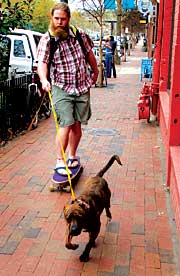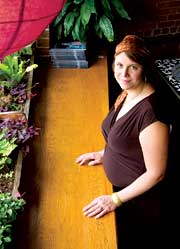The Official 2007 Visitor Guide to Asheville, published by the Buncombe County Tourism Development Authority, counts Lexington Avenue as a downtown attraction. “Asheville in one word? Funky,” advises the guide. “The area around the intersection of Walnut and Lexington, known as ‘Lower Lex,’ is a nexus for offbeat clothing boutiques, coffeehouses, music stores and an eclectic blend of businesses and interesting folks.”

The curious shopper cruising Lexington for the first time might leave with a souvenir, perhaps an irregularly shaped bar of “Dirty Hippie Soap” or a T-shirt reading, “Asheville: Nice Town, Weird Folk.” And indeed, the street’s shops, coffeehouses and restaurants are full of people whose stories and memories reflect the considerable energy they’ve invested in the area in varying ways. But Lexington’s unruly mix of business owners, employees, patrons and assorted regulars harbor a multitude of emphatic and sometimes contradictory opinions about what makes the neighborhood unique, how it’s changed, and where it’s all going.
All in the family
Like the rest of downtown Asheville, Lexington Avenue wasn’t always so lively. As recently as the early ‘90s, much of the neighborhood was still pretty raw. But creative people started moving into the dirt-cheap area, and things began to change.
Rosetta Star, who opened Rosetta’s Kitchen five years ago, remembers coming to Asheville from Old Fort as a teenager fleeing boredom. When Vincent’s Ear—a coffeehouse, bar and music venue—opened in 1993, Star became a regular. Rosetta’s Kitchen opened on a late-summer day in 2002 that coincided with the first Lexington Avenue Arts & Fun Festival. “We had a line down the staircase,” she recalls. “It was completely chaotic.”
LAAFF has grown over the years, and Rosetta’s has been roaring ever since, but as downtown property values soar and the city becomes an ever-more-popular tourist destination, things are changing. “It used to be that we knew everyone—or almost everyone—that came into the restaurant,” notes Star. “Now, summer brings us piles of tourists. No one knows where they came from or how they ever even figured out where we were.” The influx of strangers may be good for business, she adds, but it presents a unique challenge. “It’s easy to cater to the new inflow of people, but what’s harder is to hold your ground and make sure you’re serving your loyal ‘family’ first,” says Star. “That’s who I opened for.”
On the other hand, Michelle Moog-Koussa, who moved her well-established Amoré gift gallery from Battery Park Avenue to a spot near the corner of Lexington and Walnut just under a year-and-a-half ago, found herself closing up shop for good at the end of August. “From a business owner’s standpoint, there are challenges,” she explains. “People who shop up on Battery Park won’t come down to Lexington.” Meanwhile, she notes: “There are people who would like Lexington to remain what it was five years ago. I have been the victim of vandals expressing that sentiment.”
Anoop Krishnan, who opened Mela Indian restaurant with his wife three years ago, says he feels lucky to be on Lexington. “This is the most affordable place to be in business,” he proclaims. When the couple was searching for a venue, he remembers, “Other streets [in downtown Asheville] would not negotiate. … They wouldn’t even talk to me.” And while his eventual landlords liked the idea of an Indian restaurant, Krishnan did encounter some negativity in the community. “People thought I was some corporation or something, some big company coming in. And I went to one meeting, waved my hand and said: ‘I’m the big company.’ I have two kids. That’s me!”
Krishnan recalls the “nearly condemned” building he first moved into, which had formerly housed a soup kitchen. From his perspective, the common theme that all Lexington’s independent merchants share is perspiration and personal investment. “You see a lot of stores that were condemned and empty, and people are putting in their life savings and taking out loans to fix them,” he notes. That common experience, says Krishnan, has helped create the ambiance that makes the neighborhood so special. “You go to Izzy’s Coffee—I mean, there’s a gem in the city. It’s not like Starbucks. All these places, the owners are sitting right there in the store as you walk in. We work, we are here.”
Ghosts of the past, fairies of the future

Krishnan remembers going into Vincent’s Ear—in fact, he’s signed a lease on the now-vacant space, which is adjacent to Mela. Krishnan has also recruited what he calls a “focus group” that’s coming up with ideas for the space. “It’s kind of a collaboration between me and friends,” he explains. “I’ve got one guy who wants to do poetry readings, and I’ve got one person who wants to do film noir Mondays and Tuesdays. There’s a stage in there, and I know a lady who wants to put theater acts together.” It’s still in the idea phase, he adds, and he doesn’t plan to run it himself. So far, they’ve done little more than clean up the space.
One local resident, who preferred not to be named, recalls having spotted the old door to Vincent’s Ear sitting outside a few weeks ago, perhaps after one of Krishnan’s cleaning binges. “All my old graffiti tags were on that door. I wish I could’ve gotten it,” he said wistfully. “But I wasn’t going to just carry it up the street.”
Kitty Brown, the driving force behind LAAFF, echoes Krishnan’s passion for Lexington’s independent vibe. Nurturing the creativity there has become her life’s work, she says. But it’s a challenge, because of the uneasy alliance between art and commerce in the neighborhood.
“There’s a tendency when you’re creating a system to try to make it as efficient as possible,” says Brown. “But Lexington Avenue is not efficient—and it never will be. If you try and encapsulate or capture or make the mystery work for you, if you try to get your cats to line up in little rows, it won’t happen.”
Brown also worries about the area’s future. “We’ve got some big spaces down there—perfect for the Gap. And we’ve got some property owners who wouldn’t have a problem with that. … That’s what we have to avoid. But that’s hard, because lots of empowered little micro-entrepreneurs are harder to manage than one big chain store.”
The neighborhood, says Brown, “could go severely yuppie; some say it already has. But I’ve noticed that the more yuppie ventures on Lexington, well, the fairies”—she laughs—“have found it within their power to oust them. To me it’s still just as weird as ever; it’s just not necessarily as dank as it once was. I think we lost a lot when we lost Vincent’s Ear.”
Indeed, the much-lamented former club seems to be the street’s wandering ghost, popping up in almost every conversation about Lexington. It was the home away from home for Sarah Douglas, a squatter who says she hung out there constantly before hopping a train out of town a few years ago. “This street used to be full of punks, and people who wanted to change things, and everybody who gave a crap. Once they shut it down, none of the kids had anywhere to go.” Douglas, a slender 18-year-old with a Mohawk and piercing green eyes, has since returned to Asheville, but she still mourns the loss. “This town has changed so much in the past two or three years,” she says contemptuously. “The cops in this town treat homelessness like it’s a crime. They treat homeless kids a lot different than anybody with money.”
Ebb and flow
For her part, Star says the rapid pace of change in the area sometimes gives her chills. “The big red word we all use to describe it is gentrification,” which she loosely defines as “catering to people of a higher financial bracket.” At the same time, she says: “My own personality and ethics don’t allow me to just get angry. As 20 years go by, it shifts back again. I try and keep that in mind. The tide comes in and flows back out.”
Across the street and down a ways, John Brinker is behind the counter at Downtown Books and News, a fixture on Lexington for 18 years. But he recently learned that the business will have to move, because the building is slated for demolition in just over a year.
“The thing about Lexington Avenue that I think most folks are missing is this,” he says thoughtfully. “I don’t think a street can be creative: It’s people who are creative, and creative people tend to want cheap rent and places to socialize and express themselves. Asheville, and Lexington Avenue in particular, is following a familiar pattern: By making it a desirable place to live, the low-income artists and activists have helped build something that can be turned into a lot of money.” As a result, he observes, “The people who are developing and marketing Asheville, as well as many of the people who are moving here, seem to think that just the fact of being here makes them, their businesses or their condo developments ‘creative.’ There are still a lot of wonderful people around, and a lot of them can be found on Lexington Avenue. But there’s no social center for people like us anymore. The saddest thing is that many of us—myself included—came here to escape other places where the same thing was happening.”



“…Lexington Avenue wasn’t always so lively…”
WHAT?
back in the 50s and 60s when I was growing up here, Lexington Avenue was RIGHT lively! It had the Farmer’s Market, lots of ‘working ladies’ and seedy bars… but T.S. Morrison was a REAL hardware store, Asheville’s oldest, Efrid’s Department Store, the A&P;that we got our weekly groceries at, and lots of other good stuff. More people were on the sidewalks in those days than even today.
Don’t tell me Lexington Avenue is more lively now, it’s not.
And the Lexington of those days was a lot more true to realistic mountain heritage and culture than it is today. And FAR more colorful to boot.
Thanks for sharing your comments, I hadn’t heard much about what it was like in the 50s and 60s. What’s your impression of the Lexington Avenue we have today (other than not as lively or colorful than it was back then)?
“WHAT?
back in the 50s and 60s when I was growing up here, Lexington Avenue was RIGHT lively! It had the Farmer’s Market, lots of ‘working ladies’ and seedy bars…”
You’re right about that. And that was true in the 40’s as well when I was a child. It was definitely a “seedy” part of town, and I remember being given the warning as a teenager that I should never venture onto Lexington Avenue at night unless I was prepared for a knife-fight. Later in my twenties I thought I was “tough enough” to handle it. Not a place a nice boy would go though.
Things have sure changed.
It’d be nice if Asheville had what Charlottesville, VA and Ithaca, NY have : a “downtown mall” with closed off, bricked over streets just for people to walk. Honestly the traffic downtown is so grating it’s a big turn off and if just one or two streets with shops were made pedestrians only it would do a lot to create more community like Brinker talks about above. google “charlotesville downtown mall” to get some idea of what could be done here.